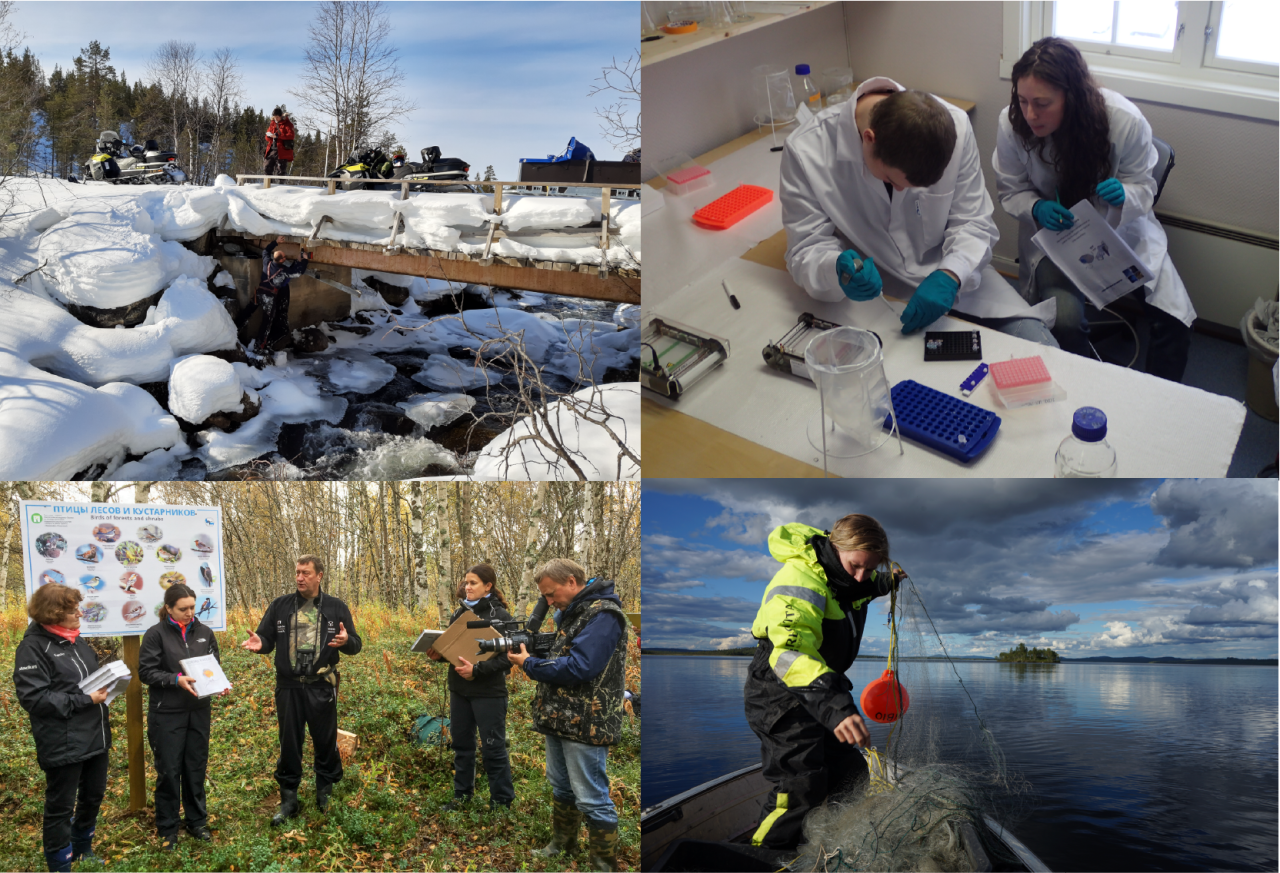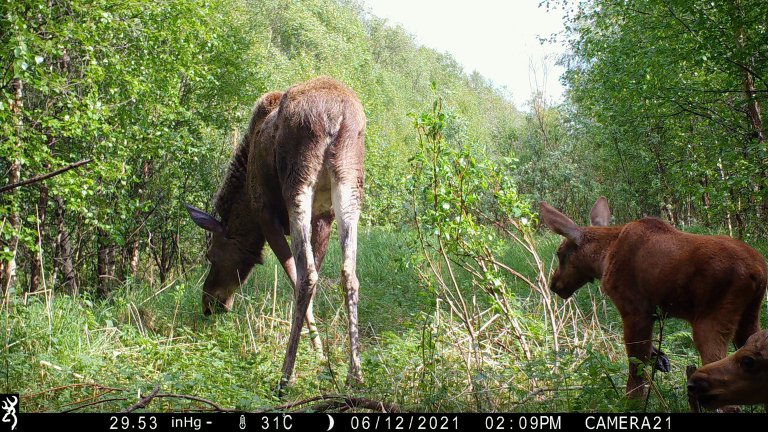
Arctic Molecular Ecology Research at Svanhovd
NIBIO Svanhovd is a hub for genetics-based research and monitoring of arctic and subarctic ecosystems. The activity is strongly committed to collaborative environmental research in the Barents region, and cooperates extensively with all countries in the region. The station disseminates knowledge and performs R&D based upon the local natural environment, and runs active outreach and environmental education programs.

Svanhovd is located in the village of Svanvik beside the Pasvik river, in the middle of the wedge of Norwegian land that separates Russia and Finland in the north. The region represents a transition zone where the eastern Siberian taiga meets the western Boreal forest, and where northern mountain birch forests transition into arctic tundra. Numerous characteristic species of plants, mammals, birds and insects are found at this intersection of different ecosystems.
Research Projects
Svanhovd is home to NIBIO’s Department of Ecosystems in the Barents Region, which specializes in the use of molecular-genetic methods for applied and basic environmental research. Svanhovd’s combination of a location in the middle of a rich nature and availability of a modern DNA laboratory provides a unique setting for such work: it is literally possible to proceed from field sampling to laboratory analyses within a few minutes.
Svanhovd lies within the core habitat of the brown bear, and the station has been at the forefront of genetic monitoring of bear populations based on non-invasive samples such as scats and hair. Other ongoing projects focus on, for example, population genetics of polar bears in Svalbard and lynx in Finland, effects of stocking and hydroelectric dams on genetic structure of fish species, inference of diet and gut microbiomes in small mammals, and communities of herbivorous insects and pollinators in subarctic and arctic habitats.
Because of the diverse research activities, many different molecular-genetic methods and marker systems are in use at Svanhovd. For example, microsatellites/STRs and ddRADseq markers are used for population-genetic analyses of vertebrate species, and barcoding and metabarcoding approaches are used for inference of insect communities as well as surveys of microbiomes or environmental DNA.
The Svanhovd Conference Centre and Other Activities
In addition to NIBIO’s Department of Ecosystems in the Barents Region and the Molecular Ecology Laboratory, the station complex encompasses the Svanhovd Conference Centre, which is ideal for arranging both large and small meetings, gatherings and conferences. The centre has a spacious auditorium and a range of different-sized meeting rooms, 50 sleeping places, attractive local food, exciting exhibitions, and beautiful surroundings.
A fertile and exciting botanical garden with Nordic and alpine perennials, food plants and summer flowers frame the Svanhovd station, while a permanent exhibition presents the unique nature, culture and history of the Øvre Pasvik National Park and the Pasvik River valley. One section of the exhibition presents facts about the life of brown bear, and about bear-related research projects and management.
Services
DNA Laboratory Svanhovd
We are offering a range of genetic analyses of mammals, fish, insects and microorganisms. The data can be used for individual discrimination, sex and species determination, population genetics and detection of selected genetic markers. We also provide development of new marker sets in new species or study systems.
More informationMolecular Ecology Lab
The Molecular Ecology Laboratory at NIBIO-Svanhovd in northern Norway applies genetic and genomic technologies to address basic and applied research problems spanning a wide range of ecological, evolutionary, and environmental questions at the individual, population, and ecosystem level.
More informationPublications
Authors
Cornelya Klutsch Simo Maduna Natalia Polikarpova Kristin Forfang Benedicte Lissner Beddari Karl Øystein Gjelland Paul Eric Aspholm Per-Arne Amundsen Snorre HagenAbstract
No abstract has been registered
Authors
Simo Maduna Jon Aars Ida Marie Luna Fløystad Cornelya Klutsch Eve Marie Louise Zeyl Fiskebeck Øystein Wiig Dorothee Ehrich Magnus Andersen Lutz Bachmann Andrew E. Derocher Tommi Nyman Hans Geir Eiken Snorre HagenAbstract
No abstract has been registered
Authors
Annika Herrero Cornelya Klutsch Katja Holmala Simo Maduna Alexander Kopatz Hans Geir Eiken Snorre HagenAbstract
No abstract has been registered
Authors
Simo Maduna Adam Vivian-Smith Ólöf Dóra Bartels Jónsdóttir Albert Imsland Cornelya Klutsch Tommi Nyman Hans Geir Eiken Snorre HagenAbstract
The lumpfish Cyclopterus lumpus is commercially exploited in numerous areas of its range in the North Atlantic Ocean, and is important in salmonid aquaculture as a biological agent for controlling sea lice. Despite the economic importance, few genetic resources for downstream applications, such as linkage mapping, parentage analysis, marker-assisted selection (MAS), quantitative trait loci (QTL) analysis, and assessing adaptive genetic diversity are currently available for the species. Here, we identify both genome- and transcriptome-derived microsatellites loci from C. lumpus to facilitate such applications. Across 2,346 genomic contigs, we detected a total of 3,067 microsatellite loci, of which 723 were the most suitable ones for primer design. From 116,555 transcriptomic unigenes, we identified a total of 231,556 microsatellite loci, which may indicate a high coverage of the available STRs. Out of these, primer pairs could only be designed for 6,203 loci. Dinucleotide repeats accounted for 89 percent and 52 percent of the genome- and transcriptome-derived microsatellites, respectively. The genetic composition of the dominant repeat motif types showed differences from other investigated fish species. In the genome-derived microsatellites AC/GT (67.8 percent), followed by AG/CT (15.1 percent) and AT/AT (5.6 percent) were the major motifs. Transcriptome-derived microsatellites showed also most dominantly the AC/GT repeat motif (33 percent), followed by A/T (26.6 percent) and AG/CT (11 percent). Functional annotation of microsatellite-containing transcriptomic sequences showed that the majority of the expressed sequence tags encode proteins involved in cellular and metabolic processes, binding activity and catalytic reactions. Importantly, STRs linked to genes involved in immune system process, growth, locomotion and reproduction were discovered in the present study. The extensive genomic marker information reported here will facilitate molecular ecology studies, conservation initiatives and will benefit many aspects of the breeding programmes of C. lumpus.
Authors
Cornelya Klutsch Simo Maduna Natalia Polikarpova Kristin Forfang Paul Eric Aspholm Tommi Nyman Hans Geir Eiken Per-Arne Amundsen Snorre HagenAbstract
Source at <a href=https://doi.org/10.1002/ece3.5191>https://doi.org/10.1002/ece3.5191</a>.
Authors
Victoria Gonzalez Mikel Moriana Armendariz Snorre Hagen Bente Lindgård Rigmor Reiersen Kari Anne BråthenAbstract
No abstract has been registered
Authors
Inger Maren Rivrud Shane Frank Richard Bischof Atle Mysterud Sam Steyaert Anne Gabriela Hertel Snorre Hagen Hans Geir Eiken Jon Swenson Andreas ZedrosserAbstract
This is an open access article under the terms of the Creative Commons Attribution License, which permits use, distribution and reproduction in any medium, provided the original work is properly cited.
Authors
Seyda Özkan_Gülzari Grete H. M. Jørgensen Svein Eilertsen Inger Hansen Snorre Hagen Ida Marie Luna Fløystad Rupert PalmeAbstract
Several non-invasive methods for assessing stress responses have been developed and validated for many animal species. Due to species-specific differences in metabolism and excretion of stress hormones, methods should be validated for each species. The aim of this study was to conduct a physiological validation of an 11-oxoaetiocholanolone enzyme immunoassay (EIA) for measuring faecal cortisol metabolites (FCMs) in male reindeer by administration of adrenocorticotrophic hormone (ACTH; intramuscular, 0.25 mg per animal). A total of 317 samples were collected from eight male reindeer over a 44 h period at Tverrvatnet in Norway in mid-winter. In addition, 114 samples were collected from a group of reindeer during normal handling and calf marking at Stjernevatn in Norway. Following ACTH injection, FCM levels (median and range) were 568 (268–2415) ng/g after two hours, 2718 (414–8550) ng/g after seven hours and 918 (500–6931) ng/g after 24 h. Levels were significantly higher from seven hours onwards compared to earlier hours (p < 0.001). The FCM levels at Stjernevatn were significantly (p < 0.001) different before (samples collected zero to two hours; median: 479 ng/g) and after calf marking (eight to ten hours; median: 1469 ng/g). Identification of the faecal samples belonging to individual animals was conducted using DNA analysis across time. This study reports a successful validation of a non-invasive technique for measuring stress in reindeer, which can be applied in future studies in the fields of biology, ethology, ecology, animal conservation and welfare.
Authors
Tommi Nyman Renske E Onstein Daniele Silvestro Saskia Wutke Andreas Taeger Niklas Wahlberg Stephan Martin Blank Tobias MalmAbstract
The insect order Hymenoptera originated during the Permian nearly 300 Mya. Ancestrally herbivorous hymenopteran lineages today make up the paraphyletic suborder ‘Symphyta’, which encompasses c. 8200 species with very diverse host-plant associations. We use phylogeny-based statistical analyses to explore the drivers of diversity dynamics within the ‘Symphyta’, with a particular focus on the hypothesis that diversification of herbivorous insects has been driven by the explosive radiation of angiosperms during and after the Cretaceous. Our ancestral-state estimates reveal that the first symphytans fed on gymnosperms, and that shifts onto angiosperms and pteridophytes – and back – have occurred at different time intervals in different groups. Trait-dependent analyses indicate that average net diversification rates do not differ between symphytan lineages feeding on angiosperms, gymnosperms or pteridophytes, but trait-independent models show that the highest diversification rates are found in a few angiosperm-feeding lineages that may have been favoured by the radiations of their host taxa during the Cenozoic. Intriguingly, lineages-through-time plots show signs of an early Cretaceous mass extinction, with a recovery starting first in angiosperm-associated clades. Hence, the oft-invoked assumption of herbivore diversification driven by the rise of flowering plants may overlook a Cretaceous global turnover in insect herbivore communities during the rapid displacement of gymnosperm- and pteridophyte-dominated floras by angiosperms.
Abstract
Interspecific brood parasitism is common in many animal systems. Brood parasites enter the nests of other species and divert host resources for producing their own offspring, which can lead to strong antagonistic parasite–host coevolution. Here, we look at commonalities among social insect species that are victims of brood parasites, and use phylogenetic data and information on geographical range size to predict which species are most probably to fall victims to brood parasites in the future. In our analyses, we focus on three eusocial hymenopteran groups and their brood parasites: (i) bumblebees, (ii) Myrmica ants, and (iii) vespine and polistine wasps. In these groups, some, but not all, species are parasitized by obligate workerless inquilines that only produce reproductive-caste descendants.We find phylogenetic signals for geographical range size and the presence of parasites in bumblebees, but not in ants and wasps. Phylogenetic logistic regressions indicate that the probability of being attacked by one or more brood parasite species increases with the size of the geographical range in bumblebees, but the effect is statistically only marginally significant in ants. However, non-phylogenetic logistic regressions suggest that bumblebee species with the largest geographical range sizes may have a lower likelihood of harbouring social parasites than do hosts with medium-sized ranges. Our results provide new insights into the ecology and evolution of host–social parasite systems, and indicate that host phylogeny and geographical range size can be used to predict threats posed by social parasites, as well to design efficient conservation measures for both hosts and their parasites. This article is part of the theme issue ‘The coevolutionary biology of brood parasitism: from mechanism to pattern’.
Authors
Alexander Kopatz Oddmund Kleven Jonas Kindberg Ilpo Kojola Jouni Aspi Göran Spong Niclas Gyllenstrand Love Dalén Ida Marie Luna Fløystad Snorre Hagen Øystein FlagstadAbstract
Background The populations of brown bear (Ursus arctos) in northern Europe have been recovering or are in the process of recovery from a severe demographic bottleneck. Especially in the main popula- tions of Scandinavia and Finland, the number of individuals has been increasing substantially, compared to the population sizes estimated 20 years ago. Also, the populations have spatially expanded, putatively restoring connectivity and gene flow between these two, formerly separated populations. The Swedish Environmental Protection Agency (Naturvårdsverket) assigned a pro- ject to assess the connectivity and gene flow between the eastern and western parts of Fen- noscandia, Finland and Scandinavia. Objective Our objective was to detect possible immigration of brown bears from eastern Fennoscandia, specifically Finland, into Scandinavia. Material and Methods For the first time with continuous sampling of brown bears, we assessed the population genetic structure and gene flow between the brown bear populations of Scandinavia and Finland. We based our analyses on the dispersing sex, male brown bears, as females tend to be philopatric. Our target area was the county of Norrbotten in northern Sweden, at the border to Finland and Norway, representing the most likely area for potential eastern immigrants into Sweden. Previous research did not reveal any influx from Finland into Sweden. However, brown bear samples from Norrbotten have to a very limited degree been included in earlier studies on genetic connectivity in the area. In addition to a large number of samples from Norrbotten and northern Finland, we included genotypes sampled in regions surrounding the target area: Västerbotten in Sweden, Troms and Finnmark in Norway and southern Finland. We utilized all samples and genotypes from male bears available, and, also, genotyped recently collected samples of male brown bears from the study area. Analyses on population genetic structure and gene flow among regions were based on 924 individual male brown bear STR-genotypes (12 short tandem repeats or microsatellite markers). In order to reveal patterns of male dispersal and the distribution of male linages we used brown bear samples genotyped with nine Y-chromosomal STRs from 826 males. KEY WORDS : connectivity, european brown bear, Fennoscandia, Finland, male gene flow, migration, population genetic structure, Scandinavia, Ursus arctos NØKKELORD : europeisk brunbjørn, Fennoskandia, Finland, genflyt, konnektivitet, migrasjon, populasjons genetisk struktur, Skandinavia, Ursus arctos
Abstract
No abstract has been registered
Abstract
No abstract has been registered
Abstract
No abstract has been registered
Abstract
1. Large-scale pattern-oriented approaches are useful to understand the multi-level processes that shape the genetic structure of a population. Matching the scales of patterns and putative processes is both a key to success and a challenge. 2. We have developed a simple statistical approach, based on variogram analysis, that identifies multiple spatial scales where the population pattern, in this case genetic structure, have highest expression (i.e. the spatial scales at which the strength of patterning of isolation-by-distance (IBD) residual variance reached maximum) from empirical data and, thus, at which scales it should be studied relative to the underlying processes. The approach is applicable to any spatially explicit pairwise data, including genetic, morphological or ecological distance or similarity of individuals, populations and ecosystems. To exemplify possible applications of this approach, we analysed microsatellite genotypes of 1,530 brown bears from Sweden and Norway. 3. The variogram approach identified two scales at which population structure was strongest, thus indicating two different scale-dependent processes: home-rangerelated processes at scales <35 km, and subpopulation division at scales >98 km. On the basis of this, we performed a scale-explicit analysis of genetic structure using DResD analysis and compared the results with those obtained by the Bayesian clustering implemented in structure. 4. We found that the genetic cluster identified in central Scandinavia by Structure is caused by IBD, with distinct gene flow barriers to the south and north. We discuss possible applications and research perspectives to further develop the approach.
Abstract
We describe Arge bella Wei & Du sp. nov., a large and beautiful species of Argidae from south China, and report its mitochondrial genome based on high-throughput sequencing data. We present the gene order, nucleotide composition of proteincoding genes (PCGs), and the secondary structures of RNA genes. The nearly complete mitochondrial genome of A. bella has a length of 15,576 bp and a typical set of 37 genes (22 tRNAs, 13 PCGs, and 2 rRNAs). Three tRNAs are rearranged in the A. bella mitochondrial genome as compared to the ancestral type in insects: trnM and trnQ are shuffled, while trnW is translocated from the trnW -trnC-trnY cluster to a location downstream of trnI. All PCGs are initiated by ATN codons, and terminated with TAA, TA or T as stop codons. All tRNAs have a typical cloverleaf secondary structure, except for trnS1. H821 of rrnS and H976 of rrnL are redundant. A phylogenetic analysis based on mitochondrial genome sequences of A. bella, 21 other symphytan species, two apocritan representatives, and four outgroup taxa supports the placement of Argidae as sister to the Pergidae within the symphytan superfamily Tenthredinoidea.
Authors
Dominique Gravel Benjamin Baiser Jennifer A. Dunne Jens-Peter Kopelke Neo D. Martinez Tommi Nyman Timothee Poisot Daniel B. Stouffer Jason M. Tylianakis Spencer A. Wood Tomas RoslinAbstract
Biogeography has traditionally focused on the spatial distribution and abundance of species. Both are driven by the way species interact with one another, but only recently community ecologists realized the need to document their spatial and temporal variation. Here, we call for an integrated approach, adopting the view that community structure is best represented as a network of ecological interactions, and show how it translates to biogeography questions. We propose that the ecological niche should encompass the effect of the environment on species distribution (the Grinnellian dimension of the niche) and on the ecological interactions among them (the Eltonian dimension). Starting from this concept, we develop a quantitative theory to explain turnover of interactions in space and time – i.e. a novel approach to interaction distribution modeling. We apply this framework to host–parasite interactions across Europe and find that two aspects of the environment (temperature and precipitation) exert a strong imprint on species co-occurrence, but not on species interactions. Even where species co-occur, interaction proves to be stochastic rather than deterministic, adding to variation in realized network structure. We also find that a large majority of host-parasite pairs are never found together, thus precluding any inferences regarding their probability to interact. This first attempt to explain variation of network structure at large spatial scales opens new perspectives at the interface of species distribution modeling and community ecology.
Abstract
No abstract has been registered
Abstract
No abstract has been registered

